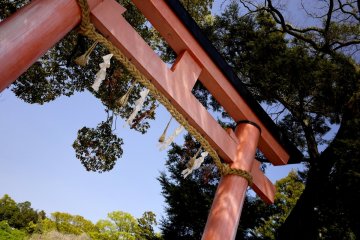
Kamigamo Shrine in Kyoto
Cathy CawoodKamigamo Shrine was established in 678 and is one of the oldest in Japan. Set in a large park, this World Heritage Site is well worth visiting.

The Kamo Shrines, Shimogamo Shrine and Kamigamo Shrine are both recognized as UNESCO World Heritage Sites. They are two of the most important and oldest shrines in Kyoto. They are located in the north of the city and are intentionally placed to ward off evil and Protect the city In fact, the two Kamo shrines are even older than the city, which became the national capital in 794.
Shimogamo Shrine is located at the confluence of the Takano and Kamo Rivers and is surrounded by a forest that contains trees up to 600 years old. The Kamigamo Shrine is about three and a half kilometers upstream and is known for two sand cones on its site, which have a cleaning function for the sanctuary and have been ritually made since ancient times.
Together the shrines host one of Kyoto's three biggest festivals, the Aoi Matsuri, which takes place on May 15th.
Romon Gates (Tower Gates) are imposing red structures built to mark entrances to important places in Japan. In Kamigamo Shrine, visitors cross a small red bridge over the water to get to the Romon Gate. The gate stands at the entrance to the Honden and Gonden buildings that lie within. Unlike torii gates, there are only a few sites in Japan that have Romon Gates.
Tatezuna are the large conical sand mounds sitting at the entrance of the main shrine building. It is said that their conical shape was constructed to represent the sacred Mt. Kouyama. Mt. Kouyama is the mountain in which the patron deity of Kamigamo Shrine is said to have descended from. The Tatezuna of Kamigamo Shrine are allegedly the inspiration for the practice of forming sand mounds or scattering sand at new construction sites to ward off evil.
Reconstructed in 1863, the Honden is the main shrine building. Gonden is an exact replica of the Honden, built as a backup for the shrine deity in case of any damage done to the original. Both are designated as National Treasures. Every year on May 15, Kyoto’s Aoi Matsuri is held at the Honden building.
20 minutes on foot from Kitaoji Station
15 minutes walk from Kitayama Station
30-minute bus ride #4 Kyoto City Bus from JR Kyoto Station get off at last stop Kamigamo Shrine

Kamigamo Shrine was established in 678 and is one of the oldest in Japan. Set in a large park, this World Heritage Site is well worth visiting.

Kamigamo Shrine located in the north skirt of Kyoto, is a famous healing power spot. And the Inner shrine, Kataoka-sha, enshrines a matchmaking God. The author of “Tales of Genji”, Lady Murasaki, also worshiped this God deeply

HEALING SPOT: Kamigamo Shrine is known for its strong healing power. And before Kyoto became capital of Japan, it was already situated here in Kyoto

The Aoi Matsuri is one of the oldest and most celebrated festivals in Japan. So much so, the word “Matsuri” originally referred only to the Aoi festival.
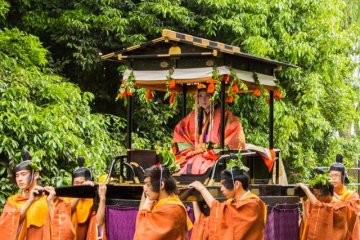
In the Aoi Matsuri, ladies dressed in the ceremonial court robes and men in traditional costumes ride on ox carriages decorated with wisteria leaves.
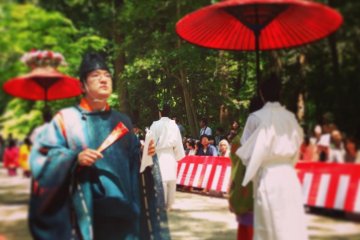
The Aoi Matsuri is one of the oldest and most celebrated festivals in Japan. So much so, the word “Matsuri” originally referred only to the Aoi festival

NAKED Summer Evening Cool is set to run from July 7th until July 17th, and will include lanterns, an illuminated Romon gate (designated as an Important Cultural Propery), windchimes, and the chance to soak your feet in Nara-no-ogawa, the river running through the shrine.

Every autumn, the grounds of Kyoto's World Heritage-listed Kamigamo Shrine are filled with the aroma of freshly baked bread for one of the city's most beloved food events: the Kyoto Bread Festival.
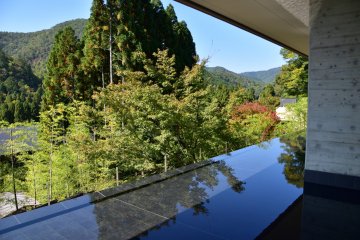
Tokyu Harvest Club Kyoto Takagamine & Viala is a gorgeous hotel inside the historical Shozan Resort Kyoto.

For two to four people a vacation rental like Kuramaguchi-An offers a lot more space, freedom and convenience than a hotel at very little extra cost.

Close to Nijo Castle in Japan's most historic city, this stylish, modern hotel is comfortable, well located and supremely affordable.

Tohichi is a new Ramen noodle restaurant in Kyoto, featuring superb clear soup and home-made noodles with Jidori chicken

Ichiwa is an thousand year old store with longstanding connections with Yasurai Matsuri festival at Imamiya Shrine selling aburi-mochi, grilled glutinous rice flour cakes.

An 80-year-old bathhouse is transformed into a cafe, whilst retaining its features reminiscent of Hayao Miyazaki's Academy Award winning film 'Spirited Away'.
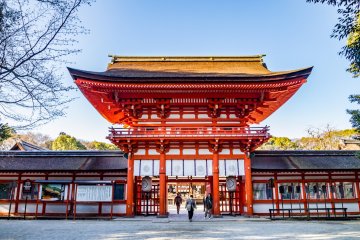
The Kamo Shrines, Shimogamo Shrine and Kamigamo Shrine are both recognized as UNESCO World Heritage Sites. They are two of the most important and oldest shrines in Kyoto. They are located in the north of the city and are intentionally placed to ward off evil and Protect the city In fact, the two Kamo shrines are even older than the city, which became the national capital in 794. Shimogamo Shrine is located at the confluence of the Takano and Kamo Rivers and is surrounded by a forest that contains trees up to 600 years old. The Kamigamo Shrine is about three and a half kilometers upstream and is known for two sand cones on its site, which have a cleaning function for the sanctuary and have been ritually made since ancient times. Together the shrines host one of Kyoto's three biggest festivals, the Aoi Matsuri, which takes place on May 15th.
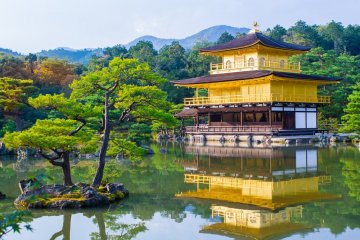
Well known as the Golden Pavilion, Kinkaku-ji is a three-story Zen Buddhist temple in northern Kyoto. Kinkaku-ji and Ginkaku-ji (Silver Pavilion) were built in the 13th century and were originally intended as noble villas for the Ashikaga shoguns. Today the building is also known as Rokuon-ji. Kinkaku-ji houses several important Buddhist relics and is a sacred place for the Rinzai sect of Japanese Buddhism. Each floor of the temple conveys a different architectural style. The first floor is in the Shinden style, the second floor in the Bukke style and the third floor in the Chinese Zen style. Thus became one of the most photogenic temples in all of Kyoto. The temple was once the retirement villa of the shogun Ashikaga Yoshimitsu. After his death in 1408 he wanted to give the building to the Rinzai sect as a Zen temple. The grounds of the Kinkaku-ji Temple used to consist of several other buildings, but unfortunately burned down in the fires and destruction during the Onin War in the 1400s. The building you see today was also rebuilt in 1955.

Known for its academic blessings, Kitano Tenmangu is a Shinto shrine in Kyoto’s Kamigyo ward that is dedicated to Sugawara no Michizane, an influential scholar and politician. The shrine was built in 947 AD and is Japan’s first shrine to enshrine an actual person as a deity. Although there are numerous shrines throughout Japan dedicated to Michizane who is mainly known as a god of academics, Kitano Tenmangu is the original one. The massive Ro-mon Gate stands as the border between the city and the shrine grounds. This wooden structure, detailed with gold-and-wooden carvings, serves as an introduction to the architectural mastery ahead. Upon entering, it is customary to go to the chozuya and perform a hand-cleansing ritual. After you complete the ritual, explore the shrine’s tranquil grounds.